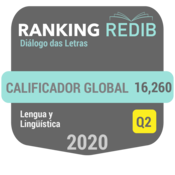O uso de videogames como textos na sala de aula: um olhar pelas lentes da abordagem multimodal
DOI:
https://doi.org/10.22297/2316-17952022v11e02205Palavras-chave:
Multiletramentos, Tecnologia, Games, Aprendizagem de Língua InglesaResumo
O uso de jogos de videogame está presente no cotidiano das pessoas de diversas faixas etárias e também no contexto escolar por meio das tecnologias como o celular. Com o objetivo de associar atividades por intermédio dessa mídia digital e o ensino de língua estrangeira, este trabalho investiga a interação por meio da leitura e as contribuições que os games de plataforma podem proporcionar aos alunos durante o processo de ensino-aprendizagem de língua inglesa. A partir das contribuições de Kress (2010), Cope, Kalantzis (2008, 2009), Grupo de Nova Londres (1996, 2000), Gee (2003), Machin (2007) e Pérez-Latorre et al. (2016), abordamos a formação do indivíduo aberto aos novos conhecimentos e baseamo-nos em um dos quatro níveis do modelo de análise para o estudo dos videogames como textos: a dimensão ludonarrativa. Os resultados revelam que a interação por meio do jogo como ferramenta pedagógica dialoga com outras interfaces semióticas, proporcionando uma postura mais crítica e reflexiva na composição textual da narrativa do game.
Downloads
Referências
COPE, B.; KALANTZIS, M. Multiliteracies: Literacy learning and the design of social futures. London: Routledge, 2009.
FERRAZ, D. M.; SANT’ANNA, P. M. Jogos digitais e educação linguística: precisamos falar mais desse encontro. Perspectiva, v. 38, n. 2, p. 1-16, 2020.
GEE, J. P. What video games have to teach us about learning and literacy. London: Palgrave Macmillan, 2003.
GUALBERTO, C. L.; SANTOS, Z. B. Multimodalidade no contexto brasileiro: um estado de arte. Delta: Documentação de Estudos em Lingüística Teórica e Aplicada, [s.l.], v. 35, n. 2, p.1-30, 2019.
KRESS, G. Before Writing: Rethinking the paths to literacy. London: Routledge, 1997.
KRESS, G.; VAN LEEUWEN, T. Reading images: the grammar of visual design. London; New York: Routledge, 2006.
KRESS, G. Discourse Analysis and Education: A multimodal Social Semiotic Approach. In: ROGERS, R. (ed.). An introduction to critical discourse analysis in education. 2nd ed. London: Routledge, 2011. p. 205-226.
MACHIN, D. Introduction to Multimodal analysis. London: Hodder Education, 2007.
MARTIN, J.R. Analysing Genre: Fucntional Parameters. In: CHRISTIE, F.; MARTIN, J.R. Genres and Institutions: Social Process in the Workplace and School. London: Cassell, 1997. p. 3-39.
MENEZES, L. M. S. Educação linguística: repensando os conceitos de língua e linguagem. In: KAWACHI-FURLAN, C. J. (org.). Bate-papo com educadores linguísticos: letramentos, formação docente e criticidade. São Paulo: Pimenta Cultural, 2019. p. 246-259.
NEW LONDON GROUP. A pedagogy of multiliteracies: designing social futures. Harvard Educational Review, v. 66, n. 1, spring 1996, p. 60-92.
NEW LONDON GROUP. Multiliteracies: Literacy learning and the design of social futures. London: Routledge, 2000.
PÉREZ-LATORRE, Ó.; OLIVA, M.; BESALÚ, R. Videogame analysis: a social-semiotic approach. London: Routledge, 2016.
Downloads
Publicado
Como Citar
Edição
Seção
Licença
Copyright (c) 2022 Diálogo das Letras

Este trabalho está licenciado sob uma licença Creative Commons Attribution 4.0 International License.
A Diálogo das Letras não se responsabiliza por conceitos e opiniões emitidos pelos autores, tampouco manifesta, necessariamente, concordância com posições assumidas nos textos publicados. Além disso, os dados e a exatidão das referências citadas no trabalho são de inteira responsabilidade do(s) autor(es). Ao submeterem seus trabalhos, os autores concordam que os direitos autorais referentes a cada texto estão sendo cedidos para a revista Diálogo das Letras; ainda concordam que assumem as responsabilidades legais relativas às informações emitidas.


















